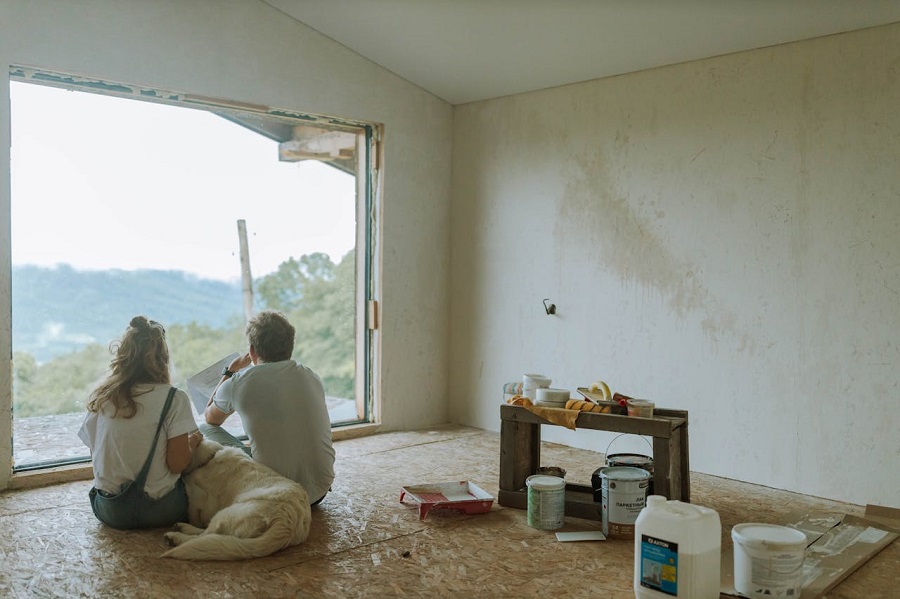Building defects UK: your legal rights & how to claim compensation

You’ve just spotted cracks in your walls, or water seeping through supposedly waterproof foundations. Your brand-new home, the biggest investment of your life, is falling apart. Building defects don’t just damage property; they destroy peace of mind and drain bank accounts. But you have legal rights, and developers have obligations. Time limits are ticking, and knowing whether your issue is latent or patent changes everything. This guide shows you exactly how to claim compensation and who pays. For specialist advice on construction & building disputes, contact a solicitor experienced in building defects before your claim window closes.

Key Takeaway: Can I claim compensation for building defects in my home?
Discovered defects in your property? Learn how to claim compensation before time runs out.
Building defect definition under UK law
A building defect is any fault in design, materials, or construction that makes your property unsafe, uninhabitable, or worth less than you paid, covering everything from foundation failures to water ingress that breaches building regulations.
The two types that determine your legal rights:
- Patent defects: Visible problems you can spot during viewings or surveys; cracked render, broken guttering, or gaps in window frames. You must raise these before completion or lose your right to claim.
- Latent defects: Hidden faults that only appear later; subsidence from poor foundations, concealed damp behind walls, or structural defects in framework covered by plasterwork. These carry longer claim periods because discovery was impossible at purchase.
What qualifies as an actionable defect:
- Structural failures: Cracking in load-bearing walls, subsidence, inadequate foundations, or roof structure problems that compromise your property’s stability.
- Water penetration: Damp from defective damp-proof courses, leaking roofs, or drainage issues causing internal damage and health hazards.
- Building regulation breaches: Work failing Part A (structure), Part C (moisture), or Part L (insulation) standards set by building control.
- Defective installations: Faulty electrics, plumbing, heating, or ventilation creating safety risks or functionality problems.
- Material defects: Substandard materials; defective concrete, inadequate insulation, or non-compliant fire safety materials affecting performance.
Common building defects that could cost you thousands
Building construction defects range from minor issues to catastrophic failures, determining whether you face a £500 repair or a £50,000 compensation claim.
The most expensive defects:
- Subsidence and foundation failure: Ground movement causing walls to crack and tilt, requiring underpinning costing £10,000-£50,000.
- Structural defects warranty issues: Load-bearing wall cracks or roof spread compromising your home’s integrity. Repairs cost £15,000-£40,000 and may require temporary accommodation.
Common new build defects triggering claims:
- Damp and water ingress: Failed damp-proof courses or poor weatherproofing. Costs £5,000-£20,000 plus damage to finishes and potential mould remediation.
- Defective drainage: Incorrectly installed drains causing flooding or ground instability. Excavation and replacement costs £3,000-£15,000.
- Poor workmanship: Incorrectly installed windows and doors, defective roofing, or electrical installations failing safety tests. Collectively costs £8,000-£25,000.
- Fire safety defects: Missing fire barriers or non-compliant cladding; the relevant defect building safety act provides extended claim periods up to 30 years for personal injury.
- Thermal performance failures: Inadequate insulation causing excessive heating costs. Remedial work costs £4,000-£12,000 and affects your property’s EPC rating.
Who pays for building defects? Your legal protection
Developers are liable for building defects, not you; multiple legal protections exist but only if you act within strict time limits.
Your primary protections:
- NHBC Buildmark warranty: Covers new build defects for 10 years; first two years for any defect, years 3-10 for major structural defects only.
- Defective Premises Act 1972: Makes builders liable for 15 years (extended from 6 years in 2022) for defects making homes unfit for habitation.
Additional legal routes for housing defects:
- Contract law claims: Six years from completion to sue for breach of contract if developers failed building regulations.
- Building Safety Act 2022: The relevant defect building safety act extends time limits to 30 years for personal injury and 15 years for building defect claims.
- Professional negligence: Architects, surveyors, and engineers owe duty of care for 6-15 years depending on when you discovered their negligence.
How much compensation for new build defects can you claim?
Compensation for new build defects covers every penny lost, repair costs, accommodation, legal fees, diminished value, and stress, with claims ranging from £5,000 to over £200,000.
What you can claim:
- Full repair costs: Every expense including scaffolding, materials, and labour. For structural defects, expect £15,000-£50,000 for underpinning or £20,000-£40,000 for roof reconstruction.
- Alternative accommodation: Hotel or rental costs while uninhabitable, typically £1,500-£4,000 monthly. NHBC covers up to two years for major structural defects warranty claims.
- Diminution in value: Difference between current worth and defect-free value. Serious defects reduce value by 5-15%; £15,000-£45,000 on a £300,000 property.
- Consequential losses: Damaged furniture, ruined belongings, storage costs, and increased heating bills. These add £2,000-£10,000 to settlements.
- Survey and expert fees: Costs for building defect surveys, building defect reports, and building defect analysis; typically £500-£3,000, fully recoverable.
- Legal costs: Solicitor fees of £3,000-£15,000 for straightforward claims. Many construction dispute solicitors work on “no win, no fee” agreements.
Professional evidence: Building defect surveys and reports
Building defect surveys provide forensic evidence winning claims; without professional proof, developers deny everything and you lose thousands.
Essential reports:
- Building defect report: Chartered surveyor inspection identifying all defects, severity, and whether patent or latent. Costs £500-£1,500 for houses. Must comply with RICS standards.
- Structural engineer’s report: Required for structural defects involving foundations or load-bearing walls. Costs £800-£2,500 with calculations proving building regulation breaches.
Specialist investigations:
- Building defect analysis: Invasive testing; opening walls, moisture readings, thermal imaging. Costs £1,200-£4,000 but provides irrefutable proof of concealed problems.
- Schedule of remedial works: Detailed specifications and costings by trade. Costs £600-£1,800, giving accurate claim figures developers can’t challenge.
- Expert witness reports: RICS-registered experts for litigation. Costs £2,500-£5,000 but essential for claims over £50,000.
Surveyors vs solicitors in building defect claims
Surveyors prove what’s wrong while solicitors force developers to pay; you need both at different stages.
When you need a surveyor first:
- Initial identification: Chartered surveyors inspect, identify defects, and classify as patent or latent. Their building defect report forms your case foundation.
- Technical causation: Surveyors explain why defects occurred; design failure, regulation breach, or poor workmanship. This building defect analysis establishes liability before lawyers get involved.
When you need a solicitor:
- Legal strategy: Solicitors specialising in construction & building disputes assess which legal route maximises compensation and negotiate settlements.
- Litigation: Only qualified solicitors can represent you in court proceedings for housing defects.
Making your building defect claim before time runs out
Time limits destroy more claims than anything; you have 6-15 years depending on which law applies.
Immediate actions (Week 1-2):
- Document now: Photograph and video every defect with timestamps. Email these to yourself creating dated evidence.
- Stop damage spreading: Place buckets under leaks, open windows for ventilation. Don’t make permanent repairs yet.
Professional assessment (Week 2-4):
- Instruct surveyor: Book building defect surveys with RICS professionals. Reports arrive within 2-3 weeks costing £500-£2,000.
- Check warranty: Locate NHBC certificate. Missing notification deadlines voids your structural defects warranty entirely.
Formal notification (Week 4-8):
- Notify liable parties: Send recorded delivery letters to developer, builder, and NHBC with surveyor reports.
- Instruct solicitor: Engage specialists in construction & building disputes and building defects once you have survey evidence.
Know your limitation periods:
- 6 years for contract claims: From completion for patent defects or discovery for latent defects.
- 15 years under Defective Premises Act: From completion for defects making property unfit for habitation.
Do I need a solicitor for building defect claims?
You need a solicitor the moment developers deny liability or offer derisory settlements; attempting to negotiate yourself against their legal teams and insurers guarantees you’ll accept 30-50% of what your claim is actually worth:
- Maximise compensation: Experienced construction & building disputes solicitors know every recoverable loss; diminution in value, consequential losses, accommodation costs, and general damages developers never volunteer. They routinely achieve settlements 2-3 times higher by identifying claims under multiple legal routes simultaneously.
- Navigate complex frameworks: Your claim might involve NHBC warranties, Defective Premises Act, Building Safety Act, contract law, and professional negligence simultaneously. Solicitors determine which combination delivers maximum recovery and manage parallel claims against developers, subcontractors, and professionals whose insurance policies provide separate compensation.
- Protect against limitation traps: Developers deliberately delay hoping you’ll miss court deadlines. Solicitors issue protective proceedings before limitation expires and comply with pre-action protocols. Missing any deadline, even by one day, can result in your entire claim being struck out.
FAQs
- What is a building defect? A building defect is any fault in design, materials, or construction making your property unsafe, uninhabitable, or worth less than you paid. The building defect definition includes foundation failures, water ingress, and regulation breaches, split into patent defects (visible) and latent defects (hidden).
- What are the common building defects? Common building defects include subsidence, structural defects like wall cracks, damp penetration, defective drainage, poor workmanship, fire safety issues, and inadequate insulation.
- Who is responsible for building defects? Developers and builders are liable. NHBC warranty covers new build defects for 10 years, Defective Premises Act provides 15 years liability, and contract law gives 6 years. The relevant defect building safety act extends claims to 30 years for personal injury. Architects and engineers can also be liable.
- What is a structural defect? A structural defect affects your property’s integrity; wall cracks, subsidence, inadequate foundations, or roof spread. These serious building construction defects compromise safety and are covered under structural defects warranty for years 3-10 of NHBC policies with claim periods up to 15 years.
Building defects can devastate your finances, but UK law provides robust protection if you act quickly. Document defects promptly, instruct chartered surveyors for evidence, and engage specialist solicitors to maximise your compensation for new build defects before limitation periods expire.
Don’t let developers walk away!
Qredible’s network of specialist construction & building disputes solicitors has recovered millions in compensation for new build defects.
KEY TAKEAWAYS:
- Building defects include patent (visible) and latent (hidden) faults like structural defects, damp, and regulation breaches that make properties unsafe or reduce value significantly.
- Legal protections provide 6-30 years to claim depending on the route, with compensation for new build defects covering repairs, accommodation, legal fees, and stress; from £5,000 to over £200,000.
- Photograph defects, instruct surveyors for building defect surveys within weeks, then engage specialist construction & building disputes solicitors before limitation periods expire.
Articles Sources
- civillitigationlawyers.co.uk - https://civillitigationlawyers.co.uk/construction-defect-claims/
- harperjames.co.uk - https://harperjames.co.uk/article/construction-defect-claims/
- yourcompensationclaim.co.uk - https://yourcompensationclaim.co.uk/construction-claims-and-dispute-resolution/defective-building-work-claims-dispute-resolution/
- england.shelter.org.uk - https://england.shelter.org.uk/housing_advice/repairs/compensation_for_disrepair_and_poor_conditions
Do you need a solicitor?
Find a solicitor on Qredible in just a few easy steps








